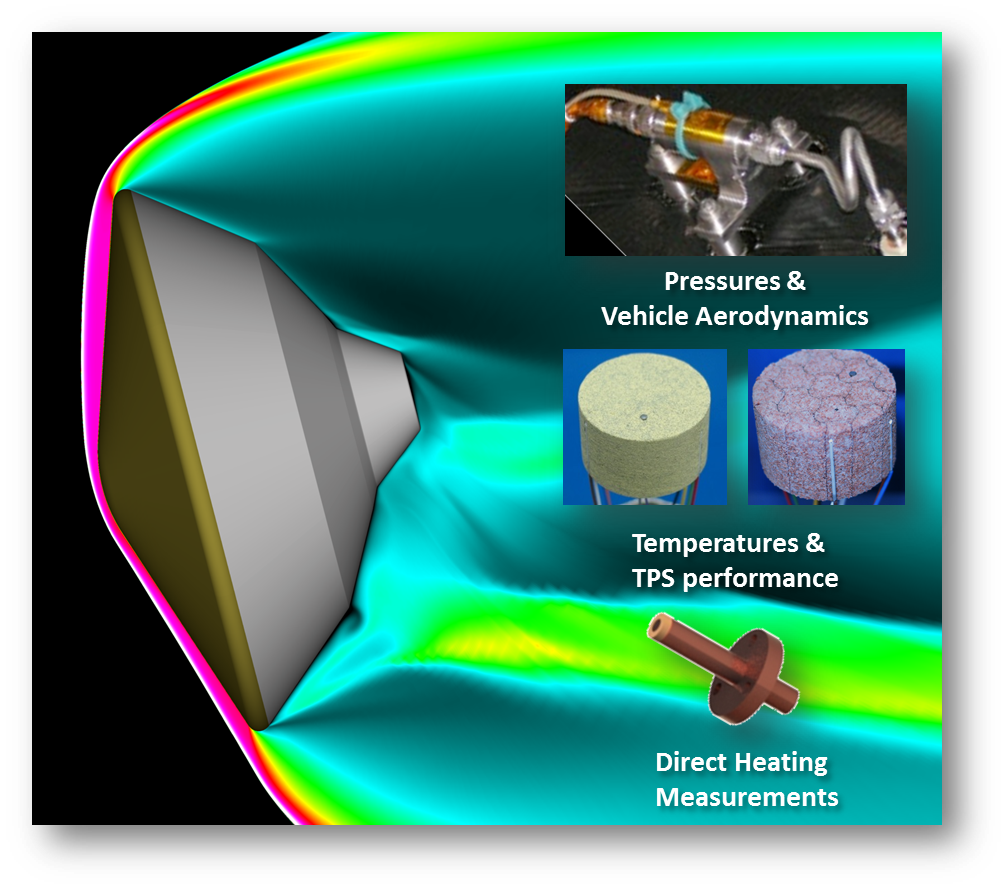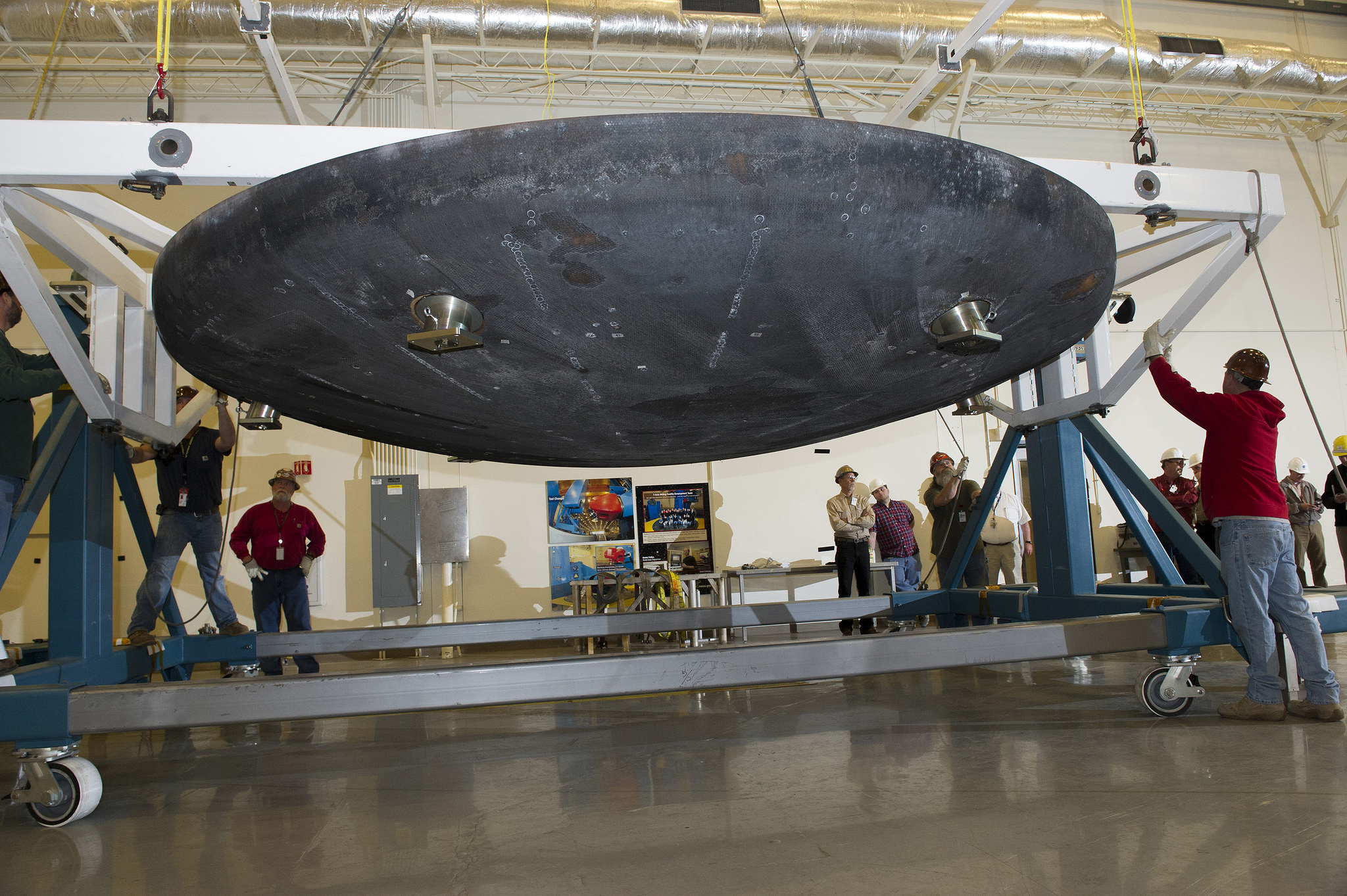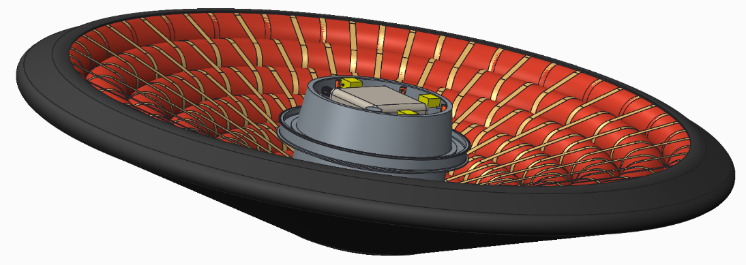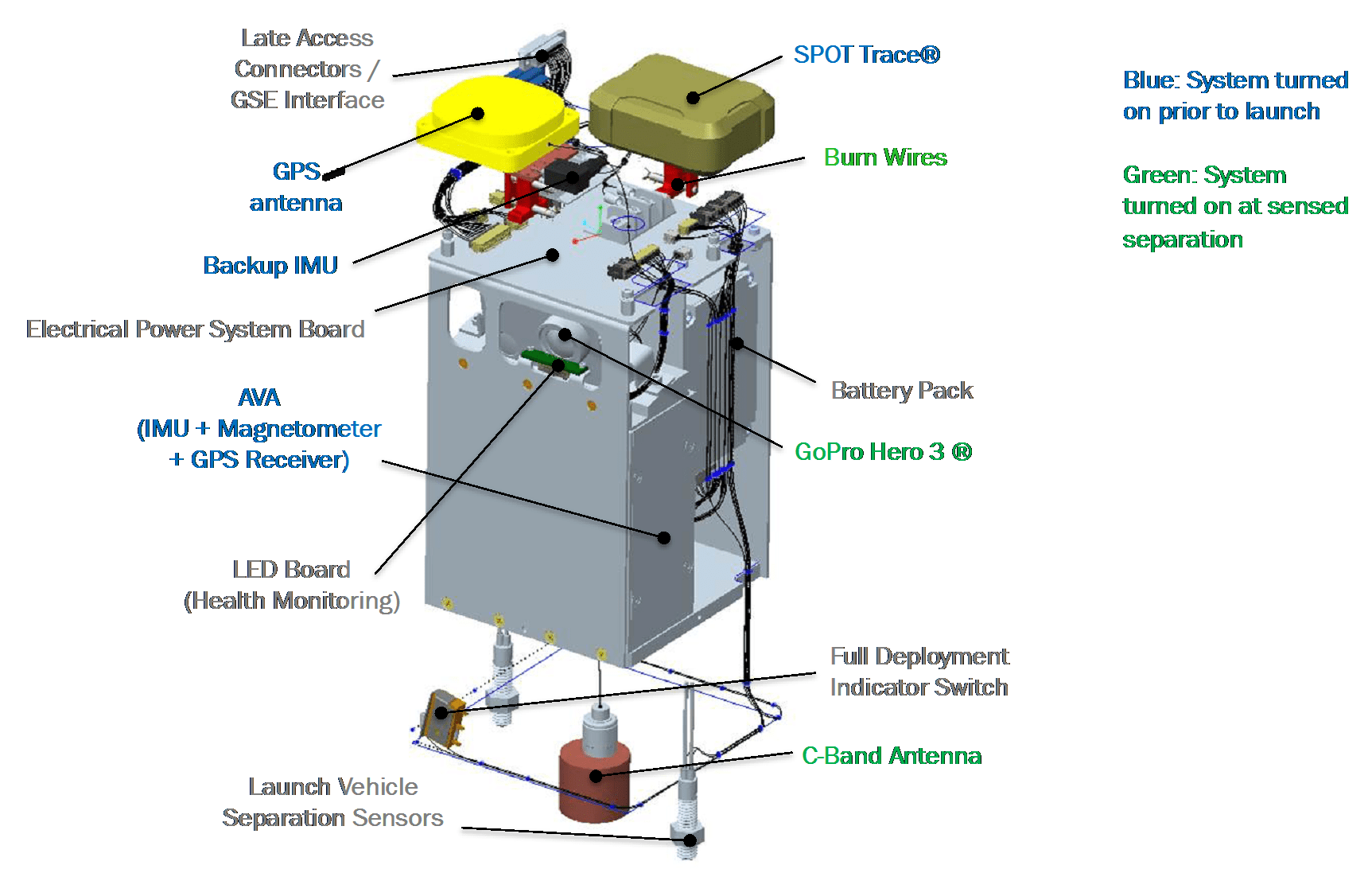The Entry System Division was instrumental in helping NASA develop the new Entry, Descent and Landing (EDL) Instrumentation Engineering Science Investigation (ESI) Goals and Objectives in 2014. The document developed identified EDL data as critical to designing and executing future missions, and that missions that involve entering planetary atmospheres are rare opportunities to collect relevant EDL flight data. NASA is now requiring proposers of missions that involve EDL into an atmosphere of a Solar System object (including the Earth) to include an ESI plan, funded outside the cost cap, to provide diagnostic and technical data about vehicle performance and entry environments. The Entry Systems and Vehicle Development Branch is filling critical roles in the design, manufacturing, and testing of entry instrumentation for Mars and Earth Entry vehicles, along with the reconstruction of the environments from the data collected.
Mars Entry Descent & Landing Instrumentation 2 (MEDLI2)
The Mars Entry Descent and Landing Instrument 2 (MEDLI2) will record critical environmental and system performance data for the Mars 2020 vehicle during the Entry and Descent phase. MEDLI2 derives its implementation approach and heritage from the highly successful MEDLI instrument flown on the Mars Science Laboratory (MSL). MEDLI2 will deliver data which extends the dataset from MEDLI, including aftbody effects (heating and drag), increased spatial observations of the aerothermal environment and associated Thermal Protection System (TPS) response, and direct observations of the aerodynamic loads applied during the supersonic flight phase. Combining the MEDLI and MEDLI2 datasets will allow entry, descent, and landing (EDL) systems to be assessed across the critical entry and descent phases which could lead to reductions in TPS mass and in the size of the landed uncertainty footprint.
The MEDLI2 Instrumented Sensor Plug (MISP) subsystem will be used to measure the aerothermodynamic heating and thermal protection system response during entry. The MISP subsystem consists of instrumented plugs installed in the heatshield and aftbody thermal protection systems, as well as heatflux sensors for direct measurement of aftbody heating. MISP will provide the most extensive aftbody instrumentation flown to Mars to date that will measure both convective and radiative heating.
Researchers at the Entry Systems and Vehicle Development Branch are involved in different aspects of the MEDLI2 project including environmental testing of MISP plugs, heatflux-sensors and radiometers, and planning and preparation efforts for post-flight data analysis and aerothermal reconstruction.
Orion EFT-1 and EM-1
NASA’s Orion spacecraft will serve as the exploration vehicle that will carry a crew to space, provide emergency abort capabilities, sustain the crew during space travel, and provide safe re-entry from deep space return velocities. A heat shield made of an ablative material, Avcoat, protects the vehicle against entry heating environment. The Exploration Flight Test 1 (EFT-1) mission, the first orbital flight of the Orion Crew Module (CM), was completed successfully in December 2014. An important objective of this flight test was to determine the performance of the Avcoat heat shield during re-entry. Engineers at the Entry Systems and Vehicle Development Branch have been involved in post-flight assessment of EFT-1 heat shield including analysis of data recorded by flight instrumentation, photography and 3D scanning of the heat shield before and after flight, extraction of samples from the heat shield, and evaluation and testing of the samples.
Exploration Mission 1 (EM1) will be the first integrated mission of the Orion spacecraft launched on the agency’s new, powerful heavy-lift rocket, the Space Launch System. An uncrewed Orion will travel thousands of miles beyond the Moon to test its systems in deep space. Upon return to Earth, Orion’s heat shield will be tested at a higher entry velocity resulting in more stressed heating environments than EFT-1. Similar to EFT-1, an important objective of this mission is to determine the performance of the Avcoat heat shield and qualify it for future crewed missions. Entry Systems and Vehicle Development Branch staff will lead data analysis, sample extraction, and evaluation efforts for the EM-1 heat shield.
Low-earth Orbit Flight Test of an Inflatable Decelerator (LOFTID)
Over a decade of work has been conducted in the development of NASA’s Hypersonic Inflatable Aerodynamic Decelerator (HIAD) technology through ground and flight tests. HIADs offer a platform for atmospheric entry of heavy payloads to planetary bodies such as Mars. This technology overcomes size and weight limitations of current rigid systems by utilizing inflatable soft goods materials that can be packed into a small volume and deployed to form a large aeroshell before atmospheric entry.
Recently, NASA was approached by the United Launch Alliance (ULA) advanced systems management and engineering, who are working to develop reusable engine capabilities for their new Vulcan launch vehicle. ULA has shown significant interest in applying a HIAD (~10m Aeroshell) to achieve this goal. In order to advance the HIAD technology for this and other applications, NASA’s Science and Technology Mission Directorate has funded the LOFTID Technology Demonstration Mission.
LOFTID is an orbital flight test that will be launched as a secondary payload on an expendable launch vehicle. The flight test will employ a 6m scale aeroshell and will provide invaluable high-energy orbital re-entry flight data for HIAD technology, while demonstrating a logical scale-up step toward ULA Vulcan main engine recovery. Engineers at NASA Ames will be leading the LOFTID instrumentation effort. This extensive instrumentation suite will include: thermocouples, heat flux sensors, a radiometer, and IR cameras to characterize the aeroheating environment and aeroshell thermal response; surface pressure measurements, an IMU, and a GPS for flight reconstruction; loadcells to measure the HIAD structural loading; and HD cameras to monitor structural response. In addition to the primary instrumentation suite, a new fiber optic sensing system will also be flown as a technology demonstration.
ADEPT SR-1 Instrumentation
The Entry Systems and Vehicle Development Branch led the effort to instrument the recent ADEPT SR-1 flight test article. The instrumentation included an Affordable Avionics Unit (AVA) and backup inertial measurement unit (IMU). The AVA included three primary subsystems: an inertial measurement unit (IMU) consisting of three-axis rate gyros and accelerometers, a magnetometer that could sense ADEPT’s orientation relative to Earth’s magnetic field, and a GPS receiver. A ruggedized, custom battery pack (~10 A-hr capacity) provided power for all of the electrical hardware, except for the GoPro® camera and SPOT Trace®, which used internal batteries.































